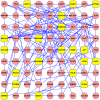An ensemble prognostic model for colorectal cancer
- PMID: 23658834
- PMCID: PMC3642113
- DOI: 10.1371/journal.pone.0063494
An ensemble prognostic model for colorectal cancer
Abstract
Colorectal cancer can be grouped into Dukes A, B, C, and D stages based on its developments. Generally speaking, more advanced patients have poorer prognosis. To integrate progression stage prediction systems with recurrence prediction systems, we proposed an ensemble prognostic model for colorectal cancer. In this model, each patient was assigned a most possible stage and a most possible recurrence status. If a patient was predicted to be recurrence patient in advanced stage, he would be classified into high risk group. The ensemble model considered both progression stages and recurrence status. High risk patients and low risk patients predicted by the ensemble model had a significant different disease free survival (log-rank test p-value, 0.0016) and disease specific survival (log-rank test p-value, 0.0041). The ensemble model can better distinguish the high risk and low risk patients than the stage prediction model and the recurrence prediction model alone. This method could be applied to the studies of other diseases and it could significantly improve the prediction performance by ensembling heterogeneous information.
Conflict of interest statement
Figures




Similar articles
-
Multivariate analysis of the prognostic value of CEA and CA 19-9 serum levels in colorectal cancer.Anticancer Res. 2000 Nov-Dec;20(6D):5195-8. Anticancer Res. 2000. PMID: 11326694
-
Clinical significance of circulating tumor cells, including cancer stem-like cells, in peripheral blood for recurrence and prognosis in patients with Dukes' stage B and C colorectal cancer.J Clin Oncol. 2011 Apr 20;29(12):1547-55. doi: 10.1200/JCO.2010.30.5151. Epub 2011 Mar 21. J Clin Oncol. 2011. PMID: 21422427
-
Preoperative serum levels of CEA and CA 19-9 and their prognostic significance in colorectal carcinoma.Anticancer Res. 1997 Jul-Aug;17(4B):2935-8. Anticancer Res. 1997. PMID: 9329568
-
Are Markers of Systemic Inflammation Good Prognostic Indicators in Colorectal Cancer?Clin Colorectal Cancer. 2017 Dec;16(4):264-274. doi: 10.1016/j.clcc.2017.03.015. Epub 2017 Mar 24. Clin Colorectal Cancer. 2017. PMID: 28412137 Review.
-
Colorectal cancer in young patients: a review of the literature.Eur J Surg Oncol. 1994 Jun;20(3):225-31. Eur J Surg Oncol. 1994. PMID: 8181597 Review.
Cited by
-
miRDRN-miRNA disease regulatory network: a tool for exploring disease and tissue-specific microRNA regulatory networks.PeerJ. 2019 Aug 6;7:e7309. doi: 10.7717/peerj.7309. eCollection 2019. PeerJ. 2019. PMID: 31404401 Free PMC article.
-
Identification of Triple-Negative Breast Cancer Genes and a Novel High-Risk Breast Cancer Prediction Model Development Based on PPI Data and Support Vector Machines.Front Genet. 2019 Mar 15;10:180. doi: 10.3389/fgene.2019.00180. eCollection 2019. Front Genet. 2019. PMID: 30930932 Free PMC article.
-
Prediction of aptamer-target interacting pairs with pseudo-amino acid composition.PLoS One. 2014 Jan 22;9(1):e86729. doi: 10.1371/journal.pone.0086729. eCollection 2014. PLoS One. 2014. PMID: 24466214 Free PMC article.
-
Integration of gene expression data identifies key genes and pathways in colorectal cancer.Med Oncol. 2021 Jan 7;38(1):7. doi: 10.1007/s12032-020-01448-9. Med Oncol. 2021. PMID: 33411100
-
Computational Identification of Guillain-Barré Syndrome-Related Genes by an mRNA Gene Expression Profile and a Protein-Protein Interaction Network.Front Mol Neurosci. 2022 Mar 17;15:850209. doi: 10.3389/fnmol.2022.850209. eCollection 2022. Front Mol Neurosci. 2022. PMID: 35370550 Free PMC article.
References
-
- Li BQ, Yu H, Wang Z, Ding GH, Liu L (2013) MicroRNA Mediated Network and DNA Methylation in Colorectal Cancer. Protein Pept Lett 20: 352–363. - PubMed
-
- Jemal A, Siegel R, Ward E, Hao Y, Xu J, et al. (2009) Cancer statistics, 2009. CA Cancer J Clin 59: 225–249. - PubMed
-
- Dukes CE (1932) The classification of cancer of the rectum. The Journal of Pathology and Bacteriology 35: 323–332.
Publication types
MeSH terms
LinkOut - more resources
Full Text Sources
Other Literature Sources
Medical

